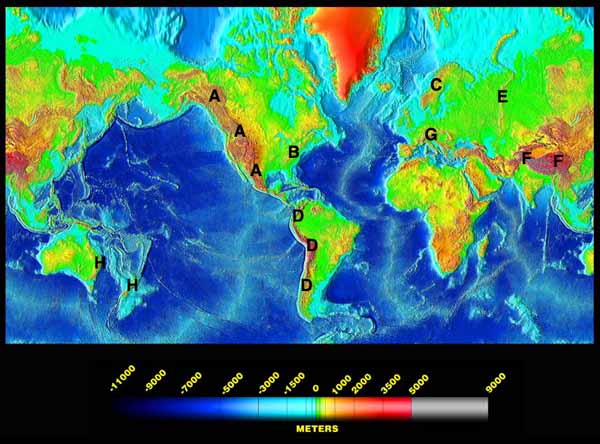 |

|
|
|
Mountain-building.
A mountain is an elevated landform with a summit and steep sides. According to scientific theory, mountains are created by a physical process called plate tectonics.
Mountains are built through a general process called "deformation" of the crust of the Earth. Deformation is a fancy word which could also mean "folding". An example of this kind of folding comes from the process described below.
When two sections of the Earth's lithosphere collide, rather than being subducted, where one slab of lithosphere is forced down to deeper regions of the Earth, the slabs pile into each other, causing one or both slabs can fold up like an accordion. This process elevates the crust, folds and deforms it heavily, and produces a mountain range. Mountain building and mantle subduction usually go together.  This image shows the topography of both land and ocean surfaces. Elevation is indicated by color. The legend below shows the relationship between color and elevation. The Earth's major mountain systems are generally colored orange to red to grey. Some of the major mountain belts on the Earth are the North American Cordillera (A), Appalachians (B), Caledonian Belt (C), Andes (D), Urals (E), Himalaya (F), Alps (G), and the Tasman Belt (H). (Source of Modified Image: NOAA, National Geophysical Data Center).
This image shows the topography of both land and ocean surfaces. Elevation is indicated by color. The legend below shows the relationship between color and elevation. The Earth's major mountain systems are generally colored orange to red to grey. Some of the major mountain belts on the Earth are the North American Cordillera (A), Appalachians (B), Caledonian Belt (C), Andes (D), Urals (E), Himalaya (F), Alps (G), and the Tasman Belt (H). (Source of Modified Image: NOAA, National Geophysical Data Center).Oceanic Trench Formations.Subduction produces a deep Ocean Trench on the ocean floor, parallel to the plate boundary. Examples are:• The Marians Trench (over 11 km deep) in the west Pacific Ocean is produced by the subduction of the Pacific plate beneath the Philippine Plate. Oceanic crust is pushed into the mantle. • The Peru-Chile ocean trench (off the west coast of South America) is formed when the Nazca Plate and the South American Plate collide. The former slips beneath the latter. Thermal shock from cold ocean water is proposed as forming ocean trenches by cracking and then cooling the crust to great depth. As soon as the fissure forms, a series of phenomena occur which I suggest give the trenches their characteristics. Cold water descends into the fissure and has the following immediate results: 1. Much more rapid heat transfer because of convection currents of water. 2. Deepening of the fissures because of the above circumstance. 3. Flaking of boulders off the side of the crack at lower depth. 4. Formation of lateral fissures due to extremely rapid heat transfer from the sides, which are warmer at depth. This accentuates the heat losses even more. |